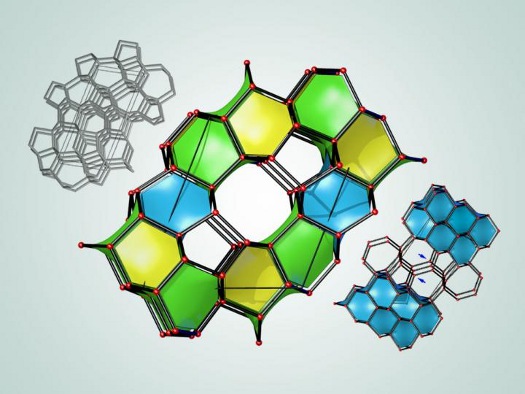 |
| January 28, 2020 | Volume 16 Issue 04 |
Designfax weekly eMagazine
Archives
Partners
Manufacturing Center
Product Spotlight
Modern Applications News
Metalworking Ideas For
Today's Job Shops
Tooling and Production
Strategies for large
metalworking plants
Hard as a diamond? Scientists predict new forms of superhard carbon
A study identifies dozens of new carbon structures that are expected to be superhard, including some that may be about as hard as diamonds.
Superhard materials can slice, drill, and polish other objects. They also hold potential for creating scratch-resistant coatings that could help keep expensive equipment safe from damage.
Now, science is opening the door to the development of new materials with these seductive qualities.
Researchers have used computational techniques to identify 43 previously unknown forms of carbon that are thought to be stable and superhard -- including several predicted to be slightly harder than or nearly as hard as diamonds. Each new carbon variety consists of carbon atoms arranged in a distinct pattern in a crystal lattice.
The study, published Sept. 3, 2019, in the journal npj Computational Materials, combines computational predictions of crystal structures with machine learning to hunt for novel materials. The work is theoretical research, meaning that scientists have predicted the new carbon structures but have not created them yet.

An illustration depicts three of 43 newly predicted superhard carbon structures. The cages colored in blue are structurally related to diamond, and the cages colored in yellow and green are structurally related to lonsdaleite. [Credit: Bob Wilder/University at Buffalo, adapted from Figure 3 in P. Avery et al., npj Computational Materials, Sept. 3, 2019.]
"Diamonds are right now the hardest material that is commercially available, but they are very expensive," says University at Buffalo chemist Eva Zurek. "I have colleagues who do high-pressure experiments in the lab, squeezing materials between diamonds, and they complain about how expensive it is when the diamonds break.
"We would like to find something harder than a diamond. If you could find other materials that are hard, potentially you could make them cheaper. They might also have useful properties that diamonds don't have. Maybe they will interact differently with heat or electricity, for example."
Zurek, PhD, a professor of chemistry in UB College of Arts and Sciences, conceived of the study and co-led the project with Stefano Curtarolo, PhD, professor of mechanical engineering and materials science at Duke University.
The quest for hard materials
Hardness relates to a material's ability to resist deformation. As Zurek explains, it means that "if you try to indent a material with a sharp tip, a hole will not be made, or the hole will be very small."
Scientists consider a substance to be superhard if it has a hardness value of over 40 gigapascals as measured through an experiment called the Vickers hardness test.
All of the study's 43 new carbon structures are predicted to meet that threshold. Three are estimated to exceed the Vickers hardness of diamonds, but only by a little bit. Zurek also cautions that there is some uncertainty in the calculations.
The hardest structures the scientists found tended to contain fragments of diamond and lonsdaleite -- also called hexagonal diamond -- in their crystal lattices. In addition to the 43 novel forms of carbon, the research also newly predicts that a number of carbon structures that other teams have described in the past will be superhard.
Speeding up discovery of superhard materials
The techniques used in the new paper could be applied to identify other superhard materials, including ones that contain elements other than carbon.
"Very few superhard materials are known, so it's of interest to find new ones," Zurek says. "One thing that we know about superhard materials is that they need to have strong bonds. Carbon-carbon bonds are very strong, so that's why we looked at carbon. Other elements that are typically in superhard materials come from the same side of the periodic table, such as boron and nitrogen."
To conduct the study, researchers used XtalOpt, an open-source evolutionary algorithm for crystal structure prediction developed in Zurek's lab, to generate random crystal structures for carbon. Then, the team employed a machine learning model to predict the hardness of these carbon species. The most promising hard and stable structures were used by XtalOpt as "parents" to spawn additional new structures, and so on.
The machine learning model for estimating hardness was trained using the Automatic FLOW (AFLOW) database, a huge library of materials with properties that have been calculated. Curtarolo's lab maintains AFLOW and previously developed the machine learning model with Olexandr Isayev's group at the University of North Carolina at Chapel Hill.
"This is accelerated material development. It's always going to take time, but we use AFLOW and machine learning to greatly accelerate the process," Curtarolo says. "The algorithms learn, and if you have trained the model well, the algorithm will predict the properties of a material -- in this case, hardness -- with reasonable accuracy."
"You can take the best materials predicted using computational techniques and make them experimentally," says study co-author Cormac Toher, PhD, assistant research professor of mechanical engineering and materials science at Duke University.
Source: University at Buffalo
Published January 2020
Rate this article
View our terms of use and privacy policy
